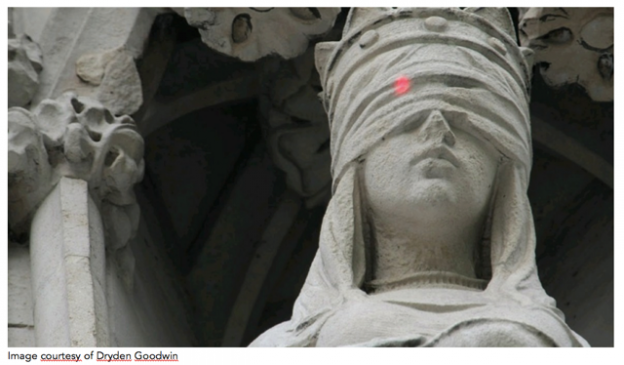Time: Monday February 01 2016, 10:00 – 17:00
Location 10:00 – 15:00: Piet Zwart Institute, Karel Doormanhof 45, Rotterdam
Location 16:00 – 17:00: De Doelen, Schouwburgplein 50, Rotterdam
Admission: free
Each year, the Department of Media Design & Communication at the Piet Zwart Institute co-operates with The International Film Festival Rotterdam and Creating 010 in organising an intensive day of mini-masterclasses around one of the IFFR theme programs.
This year, we are excited to invite five artists participating in the IFFR exhibition Scotomata and the related program Out of Sight to talk about their practice and the strategic role of the concept of “blind spots” in their work.
The following speakers will present and discuss their work and answer questions.
Dominique Somers
Dominique Somers‘ photographs, objects, films or statements are derived from or variate on the photographic disposition. A kind of playful and absurd update of conceptual photographic experiments from the old days. Somers visualises that what we call the ‘everyday’ (Georges Perec) is by no means self-evident but rather the opposite: an opaque form of blindness, a kind of sedation. Her work does not give away its intentions immediately. Most of the time her practice prefers to conceal things and concentrate on what is invisible or not present rather than to lay open its motives in a direct manner. Looking beyond the surface of her works does not always succeed straight away. Somers regularly uses the trompe-l’oeil to destabilise the (human) perception with regard to the veracity of the image.
Melvin Moti
Dutch artist, Melvin Moti pits the visionary against the cache of clichés of contemporary “spectacular” visual culture, and imagination against images. Every video of his comes out of documentary-like research and a reinterpretation of history’s mechanisms, founded on a cinematic structure that marks the passage from realistic illusion to the intangible representation of the world, from trompe-l’oeil to magic. The study on the neurological effects of long periods without light or sensorial information becomes, in Moti’s work, a dizzying descent into the realms of memory, imagination and “virtual visibility”.
Various Artists
A collective of 24 fictional artists, originated about two decades years ago in Brussels. In this open structure, a collective conceptual idea, each VA contributes its own characteristics, background and artistic interests. Fictional or not, these projects are ‘played’ by real people. Various Artists must be seen as an autonomous work, where all members work on their own specific research topics and their own artistic practice, which come together in installations or joint projects.
Marc de Blieck
With the photo exhibition Standards, Marc De Blieck shows a selection of images he has made over the years. Within the conventions of the genre, he presents himself as an executor of a collective directory, not as an “image author.” The locations that the pictures depict are of an institutional context: protected monuments and landscapes and objects in museums. The photographic positions do not reveal any new views or insights; the vantage points are not unique, nor critical.
Meggy Rustamova
Meggy Rustamova’s films, performances and installations contain an in depth poetic experience. In her work the analysis of the image – its creation, formation and staging – is very evident. Her work contains an inherent sense of humour, a soft feeling of melancholia and by times complete absurdity, which reveals a specific sensibility towards image and narrative. The stories that appear in her work are self-written and induce an alienated tale between fiction and reality. She is thus able to accomplish an universal novel disclosed in photographic imagery. Meggy Rustamova has a multifaceted practice rather than being the type to focus on one specific media or idea.
Dryden Goodwin
Dryden Goodwin’s practice incorporates drawing, often in combination with photography and live action video; he creates gallery installations, short films, projects in public space, printmaking, works on-line and soundtracks. Central to Dryden Goodwin’s practice is a fascination with drawing. However, the ways in which he explores this age-old practice are anything but traditional. He is engaged with time as well as line, and with the sculptural potential of two-dimensional images. Other concerns in his art are also strongly contemporary: the city, ideas of public and private, voyeurism, desire and emotional distance. Goodwin’s work has been shown extensively nationally and internationally, including exhibitions at Tate Modern, Tate Britain, Tate Liverpool, The Photographers’ Gallery, London, The National Portrait Gallery, London, the Venice Biennale and the Hasselblad Foundation in Gothenberg, Sweden. Recent solo exhibitions and projects include ’Unseen: The Lives of Looking’, Queen’s House, Royal Museum’s Greenwich, London, accompanied by an exhibition of drawings and artefacts featured in the film of the same title.
The IFFR exhibition Scotomata presents the following works: Museum, Danmark (Marc De Blieck) Nanthanwan Temple – Master Duangkamol Jaikompan (Edith Dekyndt) Waiting for the secret (Meggy Rustamova), Starscape, Djinn and Fake Reflection (Dominique Somers), The Light and the Paper (Sara Van Der Heide), Jardn Secrt (dans le desert) and United Colours (Various Artists).
RUNNING ORDER OF THE DAY
10:00: Doors open Piet Zwart Institute, Karel Doormanhof 45 building
10:15: Brief intro & welcome by Simon Pummell & intro to programme by Edwin Carels
10:30 – 11:15: Dominique Somers
11:15 – 12:00: Melvin Moti
12:00 – 12:45: Various Artists
Lunch break
13:30 – 14:15: Marc de Blieck
14:15 – 15:00: Meggy Rustamova
Coffee break & move to De Doelen
16:00 – 17:00: Dryden Goodwin & Tjerd de Faber – moderation Edwin Carels
17:30: Drinks at De Doelen


